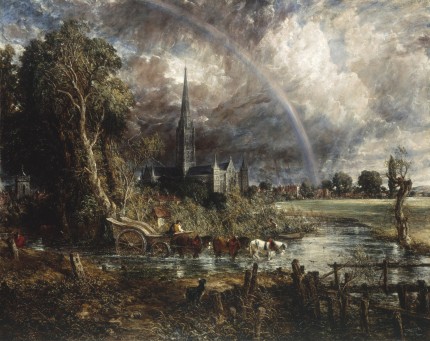
John Constable’s masterpiece, Salisbury Cathedral from the Meadows, has been secured for the British public for £23.1 million (almost $35 million) plus tax breaks. If you include the value of the tax concessions, the total sale price is equivalent to a market price of £40 million ($60 million).
The collector who owned the monumental six-foot canvas, Barclays Bank director Lord Ashton of Hyde, had loaned it to the National Gallery since 1983, but he died in 2008 and his heirs recently reclaimed it in order to sell it. A major US museum with its major US endowment was extremely interested, asking the sellers for right of first refusal. This was a serious threat. Consider the fate of J. M. W. Turner’s Modern Rome – Campo Vaccino, aka My Turner. After it sold at auction to the deep-pocketed Getty, the authorities put a temporary export ban on the painting to give UK museums a few months to raise the purchase price and keep the masterpiece in the country. The ban expired before museums could raise $45 million so the Getty Center in LA now has one of the greatest Turners of all time hanging on its wall.
Rather than risk seeing the painting disappear into a private collection in the UK or go abroad, a group of museums raised money in grants from the Heritage Lottery Fund (£15.8 million) and the Art Fund (£1 million), from private foundations and museum members.
“It’s one of the quintessential images of 19th century British art and it’s worth every penny,” Tate Britain’s Director Nicholas Serota told the BBC. […]
“This is the one of Constable’s most important paintings,” Sir Nicholas told the BBC’s Will Gompertz. “He regarded it as one of his masterpieces and always wanted it to be in the national collection.”
This collaboration between museums is an innovative approach well suited to an era of slim budgets and empty pockets. The museums in question are national — the Tate Britain, Amgueddfa Cymru – National Museum Wales, the National Galleries of Scotland — and regional — Salisbury and South Wiltshire Museum, Colchester and Ipswich Museums — who came together to form a partnership called Aspire. The deal is, the painting will travel between all the partner galleries. The rondelet began Thursday at the Tate Britain. Salisbury Cathedral from the Meadows will be on display in the Constable room until the end of the year before hitting the road. It won’t return to London until 2018.
It’s fitting that a such an iconic painting of national significance should be shared between major museums in the UK and local museums that share a thematic connection to the piece. Salisbury Cathedral is one of a series of monumental scale landscapes Constable painted to display in competition at the Royal Academy. Twelve of these large pieces are in the UK, and out of those only two of them were in private hands. Now it’s only one.
He reserved his greatest compositions for these monumental pieces because he felt they would make the strongest impact even in the crowded exhibition space of the Royal Academy. Salisbury Cathedral was first shown at the Royal Academy’s Summer Exhibition in 1831. It depicts Salisbury Cathedral against a dark sky with a cart crossing the river Nadder, a tributary of the Wiltshire Avon, in the foreground. A rainbow penetrates the black clouds and almost embraces the church and its characteristic spire. Constable thought it was his best work. He called it “The Great Salisbury” and wrote “I am told I got it to look better than anything I have yet done.”
Some see the cathedral in a storm as a statement on the political changes that were threatening the traditional temporal power of the Church of England (the Reform Act which increased the electorate, allocated more representatives to new industrial cities and removed the vestigial seats from “rotten boroughs” passed in 1832). Constable was a deeply committed member of the Church of England and a close friend of Salisbury’s Bishop John Fisher and even closer friend of his nephew Archdeacon John Fisher. They are known to have discussed religion and politics during this time.
Constable was also going through a personal crisis. His beloved wife Maria Constable had died of tuberculosis in November, 1828, and he was in deep mourning from then until the end of his life in 1837. He wrote to his brother Golding “hourly do I feel the loss of my departed Angel—God only knows how my children will be brought up…the face of the World is totally changed to me.” His best friend Archdeacon Fisher invited Constable to stay with him at his home near the cathedral twice in 1829. He encouraged him to do a painting of the Salisbury Cathedral to exhibit at the Royal Academy; a preliminary pencil sketch of the composition dates to one of those 1829 visits.
The rainbow’s end in this painting is the location of Leadenhall, Archdeacon Fisher’s home. Perhaps it signifies a more personal ray of hope during a turbulent time — the support of his friend and spiritual brother — rather than a political statement on the present and future of the Anglican Church.